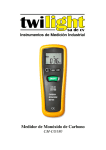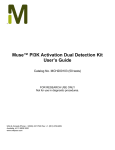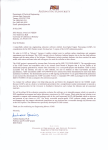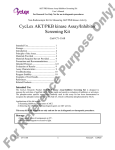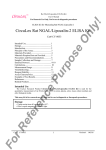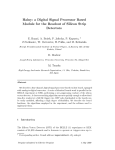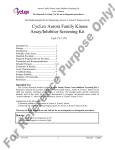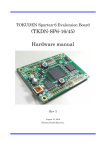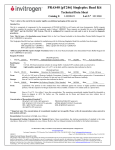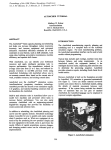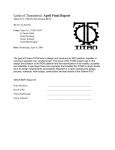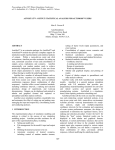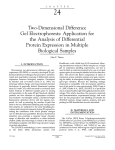Download Data Sheet
Transcript
On Non-Radioisotopic Kit for Measuring PDK1 Activity ly ! PDK1 Kinase Assay/Inhibitor Screening Kit User’s Manual For Research Use Only, Not for use in diagnostic procedures Cat# CY-1180 en ce Pu rp Intended Use................................................ 1 Storage......................................................... 1 Introduction ................................................. 2 Principle of the Assay.................................. 3 Materials Provided ...................................... 4 Materials Required but not Provided .......... 4 Precautions and Recommendations............. 5 Detailed Protocol......................................... 6-9 Evaluation of Results .................................. 10 Assay Characteristics .................................. 10 Troubleshooting ...........................................10 Reagent Stability ..........................................10 Example of Test Results...............................11-12 References.....................................................13 Related Product.............................................14 os e CycLex PDK1 Kinase Assay/Inhibitor Screening Kit Intended Use The CycLex Research Product CycLex PDK1 Kinase Assay/Inhibitor Screening Kit is designed to measure the activities of purified PDK1 for the rapid and sensitive evaluation of inhibitors using recombinant PDK1. The phospho-threonine specific polyclonal antibody used in this assay kit has been demonstrated to recognize the phospho-threonine 308 in AKT1, which is efficiently phosphorylated by PDK1. er Applications of this kit include: 1) Screening inhibitors or activators of PDK1. 2) Detecting the effects of pharmacological agents on PDK1 activity. ef This assay kit is for research use only and not for use in diagnostic or therapeutic procedures. Storage rR • Upon receipt store all components at 4°C. • Don’t expose reagents to excessive light. Fo Cat#: CY-1180 1 Version#: 120420 On Introduction ly ! PDK1 Kinase Assay/Inhibitor Screening Kit User’s Manual For Research Use Only, Not for use in diagnostic procedures Pu rp os e PDK1 (3-phosphoinositide-dependent protein kinase-1) plays an important role in insulin and growth factor signalling cascades (1, 2). It is known to phosphorylate and activate at least 24 protein kinases that belong to the AGC (cAMP-dependent, cGMP-dependent, protein kinase C) family of protein kinases. These comprise isoforms of Akt /PKB, also, p70 ribosomal S6-kinase, serum and glucocorticoid responsive kinase, p90 ribosomal S6 kinase and PKC. PDK1 activates these enzymes by phosphorylating a Ser/Thr residue in their activation loop. PDK1 is a 556 amino-acid protein comprising an N-terminal Ser/Thr kinase catalytic domain (residues 71−359) and a C-terminal pleckstrin homology (PH) domain (residues 459−550) (3, 4). The latter binds with high affinity to the second messenger phosphatidylinositol-3,4,5-trisphosphate (4, 5), generated through insulin- and growth factor-induced activation of PI3-kinase (6). PDK1 seems to exist in an active, phosphorylated configuration under basal conditions and appears to be refractive to additional activation and phosphorylation upon cell stimulation with agonists that activate PI3-kinase (7–9). In unstimulated cells, overexpressed PDK1 is mainly cytosolic, with some localization at the plasma membrane (10, 11). PH domain mutants of PDK1 that do not interact with 3´-PIs are entirely cytosolic, indicating that the membrane association of PDK1 is dependent upon a functional PH domain (11). It has been reported that high level of activated Akt is present in a large percentage (30–60%) of common tumor types, including melanoma and breast, lung, gastric, prostate, hematological, and ovarian cancers. When activated in tumor cells, Akt has multiple effects that promote disease progression, including suppression of apoptosis and stimulation of tumor cell proliferation, metabolism, and angiogenesis (12, 13). The PDK1/Akt signaling pathway plays a key role in cancer cell growth, survival, and tumor angiogenesis and thus represents an attractive target for the development of small molecule inhibitors that may be useful in the treatment of cancer. en ce Measurement of PDK1 activity rR ef er The protocol generally regarded as most sensitive for the quantitative measurement of PDK1 activity involves incubation of the PDK1 sample with substrate, either a natural or synthetic polypeptide (such as PDKtide), in the presence of Mg2+and 32P-labeled ATP. The reaction is terminated by "spotting" a sample onto a phosphocellulose P81 filter paper disc, followed by washing extensively to remove unincorporated radiolabel and the incorporated radioactivity on P81 filter is counted. While sensitive, this method is labor-intensive, generates hazardous radioactive waste and depends on a radioisotope of short half-life. It is particularly unsuitable when kinase assays are only performed on an infrequent basis. The CycLex PDK1 Kinase Assay/Inhibitor Screening Kit uses anti-phospho-AKT T308 polyclonal antibody (PPT-10) and peroxidase coupled anti-rabbit IgG antibody as a reporter molecule in a 96-well ELISA format. This assay provides a non-isotopic, sensitive and specific method to measure the activities of PDK1. Fo Cat#: CY-1180 2 Version#: 120420 On Principle of the Assay ly ! PDK1 Kinase Assay/Inhibitor Screening Kit User’s Manual For Research Use Only, Not for use in diagnostic procedures rp os e The CycLex Research Product CycLex PDK1 Kinase Assay/Inhibitor Screening Kit is a single-site, semi-quantitative immunoassay for PDK1 activity. Plates are pre-coated with a substrate-peptide corresponding to surrounding AKT1 T308, which contains threonine residues that can be efficiently phosphorylated by PDK1. The detector antibody specifically detects only the phosphorylated form of threonine residue on substrate-peptide. The CycLex PDK1 Kinase Assay/Inhibitor Screening Kit may be used to study the kinetics of a purified PDK1 as well as to screening PDK1 inhibitor or activator. To perform the test, the sample is diluted in Kinase Buffer, pipetted into the wells and allowed to phosphorylate the bound substrate following the addition of Mg2+ and ATP. The amount of phosphorylated substrate is measured by binding it with a PPT-10, an anti-phospho-AKT T308 polyclonal antibody, followed by binding with horseradish peroxidase conjugated anti-rabbit IgG, which then catalyzes the conversion of the chromogenic substrate tetra-methylbenzidine (TMB) from a colorless solution to a blue solution (or yellow after the addition of stopping reagent). The color is quantitated by spectrophotometry and reflects the relative amount of PDK1 activity in the sample. For kinetic analysis, the PDK1 containing sample is added to the wells in a similar fashion and at varying times the reaction is stopped by the addition of the chelator, sodium ethylenediaminetetraacetate (EDTA) and the amount of phosphorylated substrate determined as before. Pu Summary of Procedure Add 100 µL of sample to the wells Incubate for 30 min at 30°C en ce Wash the wells Add 100 µL of Anti-Phospho-AKT T308 Polyclonal Antibody (PPT-10). Incubate for 30 min at room temp. Wash the wells Add 100 µL of HRP conjugated anti-rabbit IgG Incubate for 30 min at room temp. er Wash the wells ef Add 100 µL of Substrate Reagent rR Add 100 µL of Stop Solution Fo Cat#: CY-1180 Measure absorbance at 450 nm 3 Version#: 120420 On Materials Provided ly ! PDK1 Kinase Assay/Inhibitor Screening Kit User’s Manual For Research Use Only, Not for use in diagnostic procedures All samples and standards should be assayed in duplicate. The following components are supplied and are sufficient for the one 96-well microtiter plate kit. os e Microplate: One microplate supplied ready to use, with 96 wells (12 strips of 8-wells) in a foil, zip-lock bag with a desiccant pack. Wells are coated with AKT308-peptide as PDK1 substrate. 10X Wash Buffer: One bottle containing 100 mL of 10X buffer containing 2 %Tween®-20 Kinase Buffer: One bottle containing 20 mL of 1X buffer; used for Kinase Reaction Buffer and sample dilution. 20X ATP: Lyophilized ATP Na2 salt. rp Anti-Phospho-AKT T308 Polyclonal Antibody (PPT-10): One vial containing 12 mL of anti-phospho-AKT T308 polyclonal antibody (PPT-10). Ready to use. Pu HRP conjugated Anti-rabbit IgG: One vial containing 12 mL of HRP (horseradish peroxidase) conjugated anti-rabbit IgG. Ready to use. Substrate Reagent: One bottle containing 20 mL of the chromogenic substrate, tetra-methylbenzidine (TMB). Ready to use. Stop Solution: One bottle containing 20 mL of 1 N H2SO4. Ready to use. en ce Materials Required but not Provided rR ef er • PDK1 Positive Control: Available from CycLex (PDK1 Positive Control: Cat# CY-E1180, One vial containing 4 units/100 µL PDK1 enzyme. Positive control should be added to the first well at 20 m units/well. For instance, diluted positive control 1:20, use 10 µL for 1 assay. (Unused PDK1 enzyme should be stored in aliquots at -70°C.) • 10X Staurosporine (1 µM): Staurosporine is available from Sigma, Cat#. S-4400. 1 mM stock solution (DMSO) diluted 1:1,000 in Kinase Buffer. • Pipettors: 2-20 µL, 20-200 µL and 200-1000 µL precision pipettors with disposable tips. • Precision repeating pipettor • Wash bottle or multichannel dispenser for plate washing. • Microcentrifuge and tubes for sample preparation. • Vortex mixer • Plate reader capable of measuring absorbance in 96-well plates at dual wavelengths of 450 nm/540 nm. Dual wavelengths of 450/550 or 450/595 nm can also be used. The plate can also be read at a single wavelength of 450 nm, which will give a somewhat higher reading. • 500 or 1000 mL graduated cylinder • Reagent reservoirs • Deionized water of the highest quality • Disposable paper towels Fo Cat#: CY-1180 4 Version#: 120420 ly ! Precautions and Recommendations On PDK1 Kinase Assay/Inhibitor Screening Kit User’s Manual For Research Use Only, Not for use in diagnostic procedures • Store the PDK1 enzyme at -70°C and the ATP at -20°C when not in use. Store all other components at 4°C. Do not expose reagents to excessive light. Avoid freeze/thaw cycles. • Allow all the components to come to room temperature before use. os e • All microplate strips that are not immediately required should be returned to the zip-lock pouch, which must be carefully resealed to avoid moisture absorption. • Do not use kit components beyond the indicated kit expiration date. • Use only the microtiter wells provided with the kit. rp • Rinse all detergent residue from glassware. • Use deionized water of the highest quality. Pu • Do not mix reagents from different kits. • The buffers and reagents used in this kit contain either sodium Kathon-CG as preservatives. Care should be taken to avoid direct contact with these reagents. • Do not mouth pipette or ingest any of the reagents. en ce • Do not smoke, eat, or drink when performing the assay or in areas where samples or reagents are handled. • Dispose of tetra-methylbenzidine (TMB) containing solutions in compliance with local regulations. • Avoid contact with Substrate Solution which contains hydrogen peroxide. • Avoid contact with Stop Solution which contains Sulfuric Acid. er • In case of contact with the Stop Solution and the Substrate Solution, wash skin thoroughly with water and seek medical attention, when necessary. • Biological samples may be contaminated with infectious agents. Do not ingest, expose to open wounds or breathe aerosols. Wear protective gloves and dispose of biological samples properly. rR ef • CAUTION: Sulfuric Acid is a strong acid. Wear disposable gloves and eye protection when handling Stop Solution. Fo Cat#: CY-1180 5 Version#: 120420 On Detailed Protocol ly ! PDK1 Kinase Assay/Inhibitor Screening Kit User’s Manual For Research Use Only, Not for use in diagnostic procedures os e The CycLex PDK1 Kinase Assay/Inhibitor Screening Kit is provided with removable strips of wells so the assay can be carried out on separate occasions using only the number of strips required for the particular determination. Since conditions may vary, running an aliquot of the appropriate PDK1 positive control (Cat# CY-E1180), separately available from CycLex, should be included in each assay. Disposable pipette tips and reagent troughs should be used for all transfers to avoid cross-contamination of reagents or samples. Preparation of Working Solution 1. Prepare a working solution of Wash Buffer by adding 100 mL of the 10X Wash Buffer (provided) to 900 mL of ddH2O. Mix well. Store at 4°C for two weeks or -20°C for long-term storage. rp 2. Prepare 20X ATP Solution by adding 1.6 mL of ddH2O to the vial of 20X ATP (provided, lyophilized). Mix gently until dissolved. The final concentration of the 20X ATP Solution should be 1.25 mM. Store the solution in small aliquots (e.g. 100 µL) at -20°C. Kinase Buffer (provided) 20X ATP (provided) 96 assays 10 assays 1 assay 9.5 mL 0.5 mL 950 µL 50 µL 95 µL 5 µL 10 mL 1000 µL 100 µL en ce Total Pu 3. Prepare Kinase Reaction Buffer (ATP plus) by mixing following reagents. You will need 80-90 µL of Kinase Reaction Buffer (ATP plus) per assay well. Mix well. Discard any unused Kinase Reaction Buffer (ATP plus) after use. Standard Assay 1. Remove the appropriate number of microtiter wells from the foil pouch and place them into the well holder. Return any unused wells to the foil pouch, refold, seal with tape and store at 4°C. er 2. Prepare all samples (diluted with Kinase Buffer as needed). All samples should be assayed in duplicate. ef 3. To assay partially purified recombinant PDK1, add 10 µL of each fraction to the wells of the assay plate on ice. Duplicate wells containing 20 m units/10 µL of PDK1 positive control (Cat # CY-E1180) should be included in each assay as a positive control for phosphorylation. rR 4. Begin the kinase reaction by addition of 90 µL Kinase Reaction buffer per well, cover with plate sealer, and incubate at 30°C for 30 minutes. 5. Wash wells five times with Wash Buffer making sure each well is filled completely. Remove residual Wash Buffer by gentle tapping or aspiration. 6. Pipette 100 µL of Anti-Phospho-AKT T308 Polyclonal Antibody PPT-10 into each well, cover with plate sealer or lid, and incubate at room temperature (ca.25°C) for 30 minutes. Fo Cat#: CY-1180 6 Version#: 120420 ly ! On PDK1 Kinase Assay/Inhibitor Screening Kit User’s Manual For Research Use Only, Not for use in diagnostic procedures 7. Wash wells five times as same as in step 5. 8. Pipette 100 µL of HRP-conjugated Anti-rabbit IgG into each well, cover with plate sealer or lid, and incubate at room temperature (ca.25°C) for 30 minutes. Discard any unused conjugate after use. os e 9. Wash wells five times as same as in step 5. 10. Add 100 µL of Substrate Reagent to each well and incubate at room temperature (ca.25°C) for 5–15 minutes. 11. Add 100 µL of Stop Solution to each well in the same order as the previously added Substrate Reagent. Pu rp 12. Measure absorbance in each well using a spectrophotometric plate reader at dual wavelengths of 450/540 nm. Dual wavelengths of 450/550 or 450/595 nm can also be used. Read the plate at 450 nm if only a single wavelength can be used. Wells must be read within 30 minutes of adding the Stop Solution. Note-1: Complete removal of liquid at each step is essential to good performance. After the last wash, remove any remaining Wash Buffer by aspirating or decanting. Invert the plate and blot it against clean paper towels. en ce Note-2: Reliable signals are obtained when either O.D. values do not exceed 0.25 units for the blank (no enzyme control), or 2.5 units for the PDK1 positive control. Note-3: If the microplate reader is not capable of reading absorbance greater than the absorbance of the PDK1 positive control, perform a second reading at 405 nm. A new O.D. values, measured at 405 nm, is used to determine PDK1 activity of off-scale samples. The readings at 405 nm should not replace the on-scale readings at 450 nm. Kinetic Assay er 1. Remove the appropriate number of microtiter wells from the foil pouch and place them into the well holder. Return any unused wells to the foil pouch, refold, seal with tape and store at 4°C. 2. Prepare all samples (diluted with Kinase Buffer as needed). All samples should be assayed in duplicate. ef 3. To assay partially purified recombinant PDK1, add 10 µL of each fraction to the wells of the assay plate on ice. Duplicate wells containing 20 m units/10 µL of PDK1 positive control (Cat # CY-E1180) should be included in each assay as a positive control for phosphorylation. rR 4. Begin kinase reaction by addition of 90 µL Kinase Reaction Buffer in duplicate per well in timed intervals (suggested interval is 4 minutes but should be individually determined for each system). After the final addition, incubate at 30°C for 20 minutes. 5. Stop the reaction by flicking out the contents. (Alternatively, the reaction may be terminated by the addition of 150 µL 0.1 M Na EDTA, pH 8.0 to each well). Fo Cat#: CY-1180 7 Version#: 120420 ly ! PDK1 Kinase Assay/Inhibitor Screening Kit User’s Manual For Research Use Only, Not for use in diagnostic procedures On 6. Wash wells five times with Wash Buffer making sure each well is filled completely. Remove residual Wash Buffer by gentle tapping or aspiration. 7. Pipette 100 µL of Anti-Phospho-AKT T308 Polyclonal Antibody PPT-10 into each well, cover with plate sealer or lid, and incubate at room temperature (ca.25°C) for 30 minutes. os e 8. Wash wells five times as same as in step 6. 9. Pipette 100 µL of HRP-conjugated Anti-rabbit IgG into each well, cover with plate sealer or lid, and incubate at room temperature (ca.25°C) for 30 minutes. Discard any unused conjugate after use. 10. Wash wells five times as same as in step 6. rp 11. Add 100 µL of Substrate Reagent to each well and incubate at room temperature (ca.25°C) for 5–15 minutes. Pu 12. Add 100 µL of Stop Solution to each well in the same order as the previously added Substrate Reagent. 13. Measure absorbance in each well using a spectrophotometric plate reader at dual wavelengths of 450/540 nm. Dual wavelengths of 450/550 or 450/595 nm can also be used. Read the plate at 450 nm if only a single wavelength can be used. Wells must be read within 30 minutes of adding the Stop Solution. en ce Recommendations Special considerations when screening activators or inhibitors In order to estimate the inhibitory effect on individual PDK1 activity in the test chemicals correctly, it is necessary to conduct the control experiment of “Solvent control” at least once for every experiment and “Inhibitor control” at least once for the first experiment, in addition to “Test sample”, as indicated in the following table. When test chemicals cause an inhibitory effect on PDK1 activity, the level of A450 is weakened as compared with “Solvent control”. The high level of A450 is not observed in “Inhibitor control” (usually A450<0.3). Kinase Reaction buffer 80 µL Solvent control 80 µL 10X Inhibitor or equivalent 10 µL - - - 10 µL - - - 10 µL 10 µL 10 µL 10 µL Test sample er Assay reagents ef Solvent for Inhibitor 10X Staurosporine (1 µM)* PDK1 positive control (1 m unit/µL)** or Purified enzyme sample Inhibitor control 80 µL rR * Cat# S-4400: See Page 4, section “Materials Required but not Provided” ** PDK1 positive control: Cat# CY-E1180: See Page 4, section “Materials Required but not Provided” 1. Following the above table, add the Reagents to each well of the microplate. Finally, initiate reaction by adding 10 µL of “PDK1 positive control” to each well and mixing thoroughly at room temperature. Cover with plate sealer or lid, and incubate at 30°C for 30 minutes. Fo Cat#: CY-1180 8 Version#: 120420 On ly ! PDK1 Kinase Assay/Inhibitor Screening Kit User’s Manual For Research Use Only, Not for use in diagnostic procedures 2. Follow the Standard Assay steps 5-12, page 6-7. 90 µL Inhibit or control 80 µL Kinase Buffer (ATP minus) - - 10X Staurosporine (1 µM)* - Purified enzyme sample PDK1 positive control (1 m unit/µL)** Buffer 10 µL - ATP minus control Positive control No enzyme control - 90 µL 90 µL 90 µL - - 10 µL - - - 10 µL - 10 µL - 10 µL - 10 µL rp Kinase Reaction buffer Test Sample Pu Assay reagents os e Special considerations when measuring precise PDK1 activity In order to measure the activity of PDK1 correctly, it is necessary to conduct the control experiment of “Inhibitor control” at least once for every experiment and “ATP minus control” at least once for the first experiment, in addition to “No enzyme control” as indicated in the following table. Although the level of A450 increases in “Test sample” when PDK1 enzyme activity is in the sample, the high level of A450 is not observed in “Inhibitor control”, “ATP minus control” and “No enzyme control”. * Cat# S-4400: See Page 4, section “Materials Required but not Provided” ** PDK1 positive control: Cat# CY-E1180: See Page 4, section “Materials Required but not Provided” en ce 1. Following the above table, add the Reagents to each well of the microplate. Finally, initiate the reaction by adding 10 µL of “Purified enzyme sample” or “Buffer” to each well and mixing thoroughly at room temperature. Cover with plate sealer or lid, and incubate at 30°C for 30 minutes. rR ef er 2. Follow the Standard Assay steps 5-12, page 6-7. Fo Cat#: CY-1180 9 Version#: 120420 On Evaluation of Results ly ! PDK1 Kinase Assay/Inhibitor Screening Kit User’s Manual For Research Use Only, Not for use in diagnostic procedures 1. Average the absorbance values for the PDK1 sample duplicates (positive control) and all experimental sample duplicate values (when applicable). When PDK1 positive control (20 m units/assay) is included as an internal control for the phosphorylation reaction, the absorbance value should be greater than 1.0 with a background less than 0.15. os e 2. For kinetic analysis, on graph paper, plot the mean absorbance values for each of the time points on the Y-axis versus the time of each reaction (minutes) on the X-axis. Assay Characteristics rp The CycLex Research Product CycLex PDK1 Kinase Assay/Inhibitor Screening Kit has been shown to detect the activity of purified recombinant PDK1. The assay shows good linearity of sample response. Troubleshooting Pu 1. The CycLex PDK1 positive control (Cat# CY-E1180) should be run in duplicate, when a standard assay is being performed, using the protocol described in the “Detailed Protocol”. Incubation times or temperatures significantly different from those specified may give erroneous results. en ce 2. The reaction curve is nearly a straight line if the kinetics of the assay is of the first order. Variations in the protocol can lead to non-linearity of the curve, as can assay kinetics of other than first order. For a non-linear curve, point to point or quadratic curve fit methods should be used. 3. Poor duplicates, accompanied by elevated values for wells containing no sample, indicate insufficient washing. If all instructions in the “Detailed Protocol” were followed accurately, such results indicate a need for washer maintenance. 4. Overall low signal may indicate that desiccation of the plate has occurred between the final wash and addition of Substrate Reagent. Do not allow the plate to dry out. Add Substrate Reagent immediately after wash. er Reagent Stability ef All of the reagents included in the CycLex Research Product CycLex PDK1 Kinase Assay/Inhibitor Screening Kit have been tested for stability. Reagents should not be used beyond the stated expiration date. Upon receipt kit reagents should be stored at 4°C, except the ATP must be stored at -20°C. Coated assay plates should be stored in the original foil bag sealed by the zip lock and containing a desiccant pack. rR For research use only, not for use in diagnostic or therapeutic procedures Fo Cat#: CY-1180 10 Version#: 120420 On Example of Test Results Fig.1 Dose dependency of recombinant PDK1 enzyme reaction 3.5 os e 3.0 2.5 2.0 1.5 rp A450 ly ! PDK1 Kinase Assay/Inhibitor Screening Kit User’s Manual For Research Use Only, Not for use in diagnostic procedures 1.0 Pu 0.5 0.0 0 10 20 30 40 PDK1 Positive control (m units) 3.5 3.0 2.0 er A 450 2.5 en ce Fig.2 Time course of recombinant PDK1 enzyme reaction 1.5 ef 1.0 0.5 rR 0.0 Fo Cat#: CY-1180 0 10 20 30 40 50 Reaction Time (min.) 11 60 Version#: 120420 12000 y = 51.672x + 816.23 10000 R = 0.9932 2 os e 8000 <s/v> On Fig.3 Km for ATP (recombinant PDK1) ly ! PDK1 Kinase Assay/Inhibitor Screening Kit User’s Manual For Research Use Only, Not for use in diagnostic procedures 6000 Km for ATP 15.796 (uM) 4000 rp 2000 0 50 100 150 ATP conc. (uM) <s> 200 Pu 0 Fig.4 Effect of broad-spectrum kinase inhibitor staurosporine on PDK1 activity 110 en ce 90 80 70 60 50 40 er Rerated intensity (% of control) 100 30 ef 20 10 rR 0 Fo Cat#: CY-1180 0.1 1 10 100 Staurosporine (nM) 12 1000 Version#: 120420 On References ly ! PDK1 Kinase Assay/Inhibitor Screening Kit User’s Manual For Research Use Only, Not for use in diagnostic procedures 1. Toker A, and Newton AC (2000) Cellular signaling: pivoting around PDK-1. Cell 103: 185–188 2. Mora A, Komander D, van Aalten DMF, Alessi DR (2004) PDK1, the master regulator of AGC kinase signal transduction. Semin Cell Dev Biol 15: 161–170 os e 3. Alessi DR, James SR, Downes CP, Holmes AB, Gaffney PR, Reese CB, Cohen P (1997) Characterization of a 3-phosphoinositide-dependent protein kinase which phosphorylates and activates protein kinase Balpha. Curr Biol 7: 261–269 rp 4. Stephens L, Anderson K, Stokoe D, Erdjument-Bromage H, Painter GF, Holmes AB, Gaffney PR, Reese CB, McCormick F, Tempst P, Coadwell J, Hawkins PT (1998) Protein kinase B kinases that mediate phosphatidylinositol 3,4,5-trisphosphate-dependent activation of protein kinase B. Science 279: 710–714 Pu 5. Currie RA, Walker KS, Gray A, Deak M, Casamayor A, Downes CP, Cohen P, Alessi DR, Lucocq J (1999) Role of phosphatidylinositol 3,4,5-trisphosphate in regulating the activity and localization of 3-phosphoinositide-dependent protein kinase-1. Biochem J 337 (Part 3): 575–583 6. Vanhaesebroeck B, Leevers SJ, Ahmadi K, Timms J, Katso R, Driscoll PC, Woscholski R, Parker PJ, Waterfield MD (2001) Synthesis and function of 3-phosphorylated inositol lipids. Annu Rev Biochem 70: 535–602 en ce 7. Alessi, D. R., Deak, M., Casamayor, A., Caudwell, F. B., Morrice, N., Norman, D. G., Gaffney, P., Reese, C. B., MacDougall, C. N., Harbison, D. et al. (1997) 3-Phosphoinositide-dependent protein kinase-1 (PDK1): structural and functional homology with the Drosophila DSTPK61 kinase. Curr. Biol. 7, 776–789 8. Pullen, N., Dennis, P. B., Andjelkovi, M., Dufner, A., Kozma, S. C., Hemmings, B. A. and Thomas, G. (1998) Phosphorylation and activation of p70s6k by PDK1. Science 279, 707–710 9. Casamayor, A., Morrice, N. and Alessi, D. R. (1999) Phosphorylation of Ser-241 is essential for the activity of 3-phosphoinositide-dependent protein kinase 1: identification of five sites of phosphorylation in vivo. Biochem. J. 342, 287–292 er 10. Anderson, K. E., Coadwell, J., Stephens, L. R. and Hawkins, P. T. (1998) Translocation of PDK-1 to the plasma membrane is important in allowing PDK-1 to activate protein kinase B. Curr. Biol. 8, 684–691 ef 11. Currie, R. A., Walker, K. S., Gray, A., Deak, M., Casamayor, A., Downes, C. P., Cohen, P., Alessi, D. R. and Lucocq, J. (1999) Role of phosphatidylinositol 3,4,5-trisphosphate in regulating the activity and localization of 3-phosphoinositide-dependent protein kinase-1. Biochem. J. 337, 575–583 rR 12. Hanada, M., Feng, J., and Hemmings, B. A. (2004) Biochim. Biophys. Acta 1697, 3-16 13. Shiojima, I., and Walsh, K. (2002) Circ. Res. 90, 1243-1250 Fo Cat#: CY-1180 13 Version#: 120420 On Related Products ly ! PDK1 Kinase Assay/Inhibitor Screening Kit User’s Manual For Research Use Only, Not for use in diagnostic procedures en ce Pu rp os e * PDK1 Positive control: Cat# CY-E1180 er PRODUCED BY ef CycLex Co., Ltd. 1063-103 Terasawaoka Ina, Nagano 396-0002 Japan Fax: +81-265-76-7618 e-mail: [email protected] URL: http://www.cyclex.co.jp rR CycLex/CircuLex products are supplied for research use only. CycLex/CircuLex products and components thereof may not be resold, modified for resale, or used to manufacture commercial products without prior written approval from CycLex Co., Ltd.. To inquire about licensing for such commercial use, please contact us via email. Fo Cat#: CY-1180 14 Version#: 120420














